June 30th, 2016
Back to holiday blogging! This time I’m visiting another traditional village in Anhui called Hongcun (宏村).
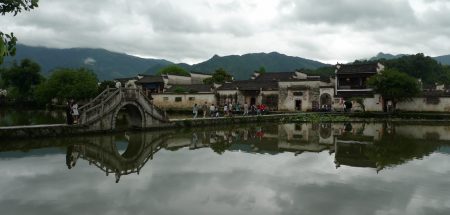
If it looks vaguely familiar it’s because it’s often used as a film set. Most notably for Crouching Tiger Hidden Dragon. This scene with the bridge reflecting on the lake is a favourite among Chinese artists.
The village was designed during the Ming and Qing dynasties along Feng Shui principles. The layout is supposed to resemble the entrails of an ox with the lakes representing different organs and the little flowing streams, like the one on the right here, representing the intestines.
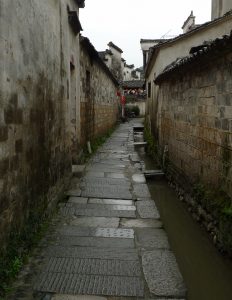
Below is “half moon lake”. This represents the stomach and the little streams flow away from it. It’s really photogenic, even on a cloudy day.
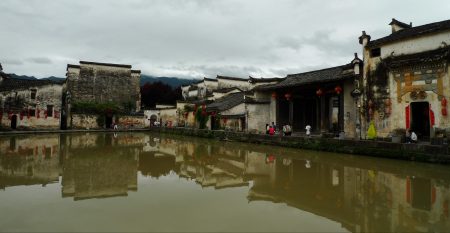
In addition to the water features there is the usual array of houses and temples to wander around. The school house is particularly good. People actually still live here: I met a really friendly lady who had a shop selling tea she grew on here farm, and there’s a couple of other interesting shops dotted around.
To get there I took the bus from the main bus station in Tunxi. It took an hour and a half but was clean and the view from the bus when it got off the main road was amazing. There seems to be some confusing and contradictory transport information online: I went in May 2016 and the busses left every hour at half past and returned on the hour until 5pm. You can buy the return ticket when you board the bus in the car park, but you need to buy the outgoing ticket from the office in the bus station.
The bus stops at a couple of other “scenic villages” on the way. There wasn’t enough time to check them out, but they didn’t look as impressive as Hongcun.
June 29th, 2016
I tried to escape the post-Brexit gloom on Sunday by going for a little walk from near High Wycombe to Gerrards Cross. Was pleasant enough, if uneventful. There are a lot of very nice houses, or rather mansions, in this area.
I haven’t been doing very well with adventuring this year. A combination of a hectic house move and travelling a lot for work. Never mind, the upside of post-Brexit recession unemployment will be more time to explore!
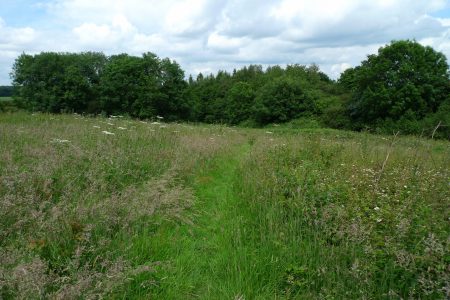
June 28th, 2016
Qiyun Shan (齐云山) is one of the Four Sacred Mountains of Taoism and about 30 minutes drive or 45 minutes bus ride from where I was staying in Tunxi. The name means something like “level-with-clouds mountain”. Although it wasn’t raining when I arrived, I was ominously the only passenger on the bus up to the entrance. Just as I got off the most almighty downpour started, the like of which I have never seen before. I was trapped inside the little tourist information building for nearly an hour and a half before it eased off enough to go outside. That afternoon I found out it had been, even for China, an unusually extreme amount of rain because a number of roads and rivers had flooded.
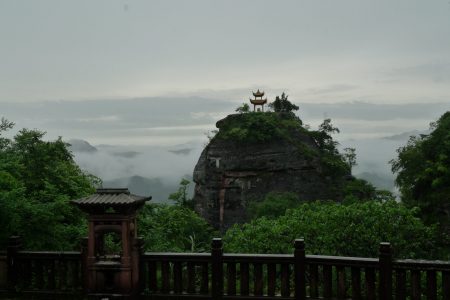
Being a holy mountain you’d expect lots of temples and you wouldn’t be disappointed. There’s a village too to explore but was utterly deserted. I think it made for some atmospheric photos though.
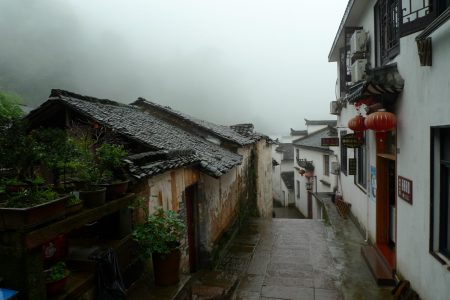
I didn’t dare hike up to the summit because there’d been several lightning strikes and the path looked a bit slippery and treacherous. On a nicer day it might be fun to walk from the summit back down to the base as there are several attractions part way down the mountain I didn’t visit. But sadly I’m unlikely to have an opportunity to go back. Maybe one of you readers will though!
June 26th, 2016
Due to a catastrophic lack of forward planning I’d only planned one day out on my trip to Anhui and figured I’d leave the rest to happenstance. The guidebook mentioned this placed called Jixi Longchuan (绩溪龙川) was worth a visit. So I set about trying to get there.
The great thing about China is that if there’s no train to the place you want to go you can just wait a year or two and they’ll build a high speed rail line for you. The guidebook suggested taking a 1.5 hour bus, but a quick search on Ctrip reveals you can now take the train! The taxi driver told me this new “North” station was only built last year. It’s suitably shiny and rather empty.
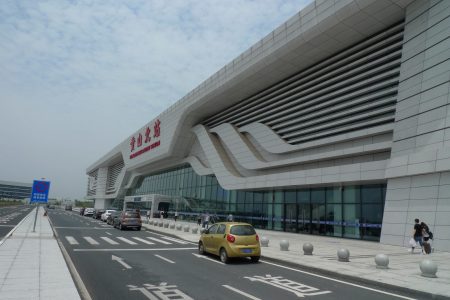
After a bit of a fail where I bought a ticket for the wrong day on Ctrip (I managed to salvage it by explaining how I’d 买错了), I rode the high speed train for a whole fifteen minutes to Jixi.
This was also a mistake as Jixi Longchuan (scenic spot) is not actually in Jixi (industrial town seldom visited by foreigners). But whatever, the 30 minute taxi ride to the right place was so cheap it didn’t really matter.
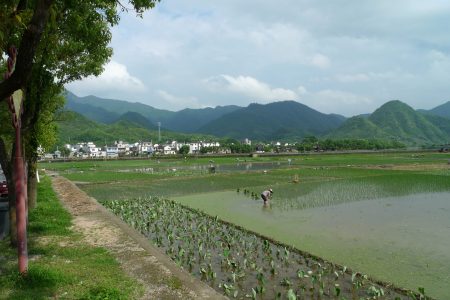
The scenery out here is gorgeous. I think it’s my first proper outing to the Chinese countryside. Some older people in the fields planting rice.
The attraction here is another well preserved old village you pay a nominal fee to wander around. I like these places a lot, as you might have gathered, and there’s a few more to blog about later in the week.
The “long” 龙 in Longchuan means “dragon” and refers to the snaking line of pebbles down the walkway on one side of the river. The other side is supposed to be a phoenix. Not sure what a “chuan” 川 is but it’s the same character as in Sichuan (四川) – something to do with rivers or plains. Another little factoid: the village used to be a centre of paper making and has a small exhibition on it.
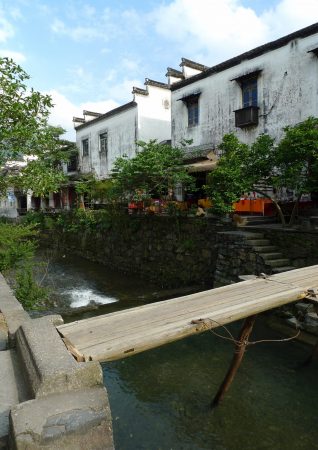
At the other end of the village is this river which you can wander along and admire the curiously shaped mountains.
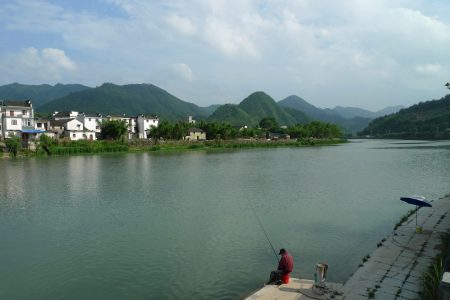
There’s maybe 2-3 hours exploring to be had and afterwards I caught the bus back to Jixi. Here’s the train pulling in. The evening was lovely. Unfortunately, it was the last rain free day of that week. :(
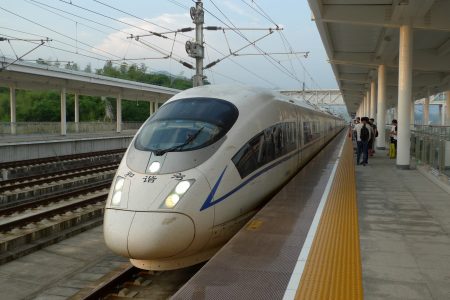
June 25th, 2016
With the forecast suggesting torrential rain for the whole week, the Monday on which I arrived in Tunxi looked like the best day for ascending the local mountain, Huangshan.
Huangshan, 黄山 means Yellow Mountain and is one of the top scenic spots in China. It’s actually the main reason I visited Anhui, the result of a lazy Google for “best places to visit in China”. Getting there from Tunxi is quite straightforward: a 20元 tourist bus to a drab town called Tangkou and then a shuttle bus up to the trail head or cable car.
The entrance fee to the mountain is very high: 230元. Makes me so glad to live in a country with free access to national parks. The pass is valid for three days I think, but after one day I thought I’d done the majority of it.
It’s possible to take a cable car to the summit, but what’s the point of that? It’s much more fun climbing up the endless steps. There’s a couple of different routes. I think they’re all of similar difficulty but the one I picked was the most direct which means it’s also used by these porters carrying supplies to the hotels and restaurants on the summit. Rather them than me. They had massive calves though.
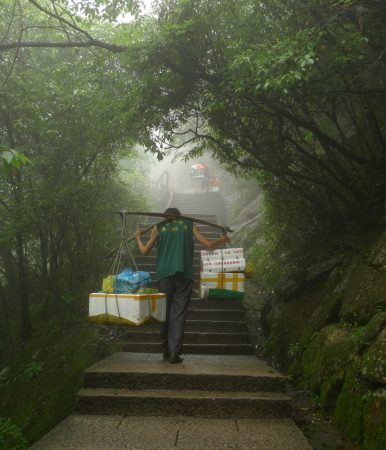
I was struck by how similar this misty path seemed to the one up Qixingshan in Taiwan which I climbed last year. At 1800m though Huangshan is a lot higher. Imagine climbing a never ending staircase in sweltering heat for two or three hours and you get the idea. Still, near the top the views were pretty good!
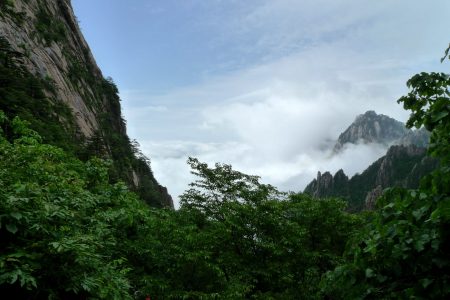
Huangshan is famous for this “sea of clouds” scene, but the weather wasn’t cooperating that day and this was the best shot I got. I met a group of photographers near the top anxiously waiting for “it” to happen. Not sure if they were successful or not
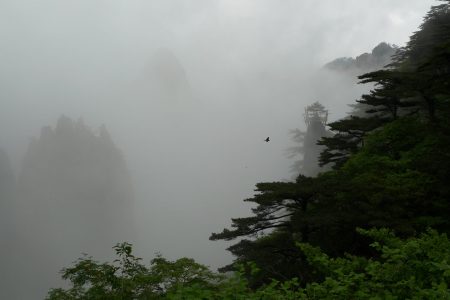
Once I reached the summit the mist really rolled in and there wasn’t much in the way of views. The summit is more of a plateau connecting several peaks than a single isolated peak, and is quite developed with expensive hotels and souvenir shops. I ambled around some of the trails before, a bit exhausted, I took the cable car back down.
June 21st, 2016
So after I’d spent a week working in Suzhou it was a bank holiday weekend and I was owed a day for working on the last bank holiday, so I took the whole week off and went adventuring. Where to go though? China is quite big. I decided to try somewhere a bit more rural and went to Anhui which is south-west-ish of Suzhou and Shanghai. I stayed in Tunxi, which is the tourist hub of the area. And how to get there? I could fly, but internal short haul flights are a bit miserable. Surely overnight train is the glamorous way to travel! And also a good way to practice Chinese with your travelling companions. The journey took about 10 hours from Suzhou and 11 hours back to Shanghai the following Friday night. Here’s my bunk in the four person compartment! I opted for the “soft sleeper” ticket as it wasn’t much more expensive than the “hard sleeper” option, and something about “hard sleeper” didn’t sound too appealing.
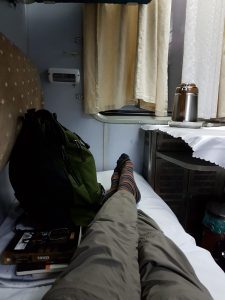
Arriving bright and early at seven in the morning, I immediately decided to hike up a 1800m mountain. But more on that later. Tunxi itself doesn’t have a whole lot of attractions. Those it has are mostly clustered around this street 老街 “Old Street”. Which is a very well preserved Qing dynasty market street.
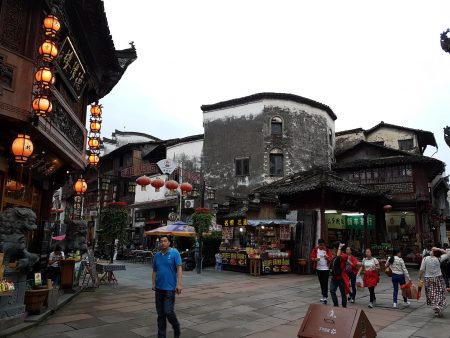
There’s a huge number of seemingly identical shops selling tea and calligraphy equipment. I’ve no idea how the local economy supports this, and there didn’t seem to be that many visitors or local customers. The local tea that everywhere is selling is Maofeng 毛峰. It seems to be the done thing to drink it with the leaves in a glass which takes a bit of getting used to but afterwards is quite fun. The leaves are so big there’s little chance of accidentally eating them.
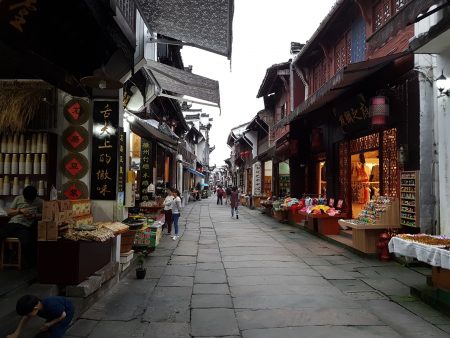
I stayed at this B&B-esque hotel in an alleyway just off the street above. It consists of two old merchants’ houses with a little courtyard in between and the family that run it live downstairs. The rooms are decorated in this lovely traditional wooden “Huizhou” style and my bathroom even had a revolutionary poster. What more do you want?!
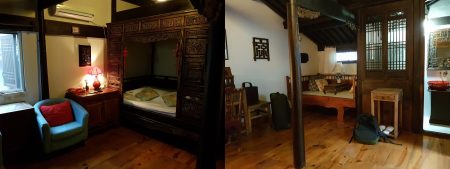
If you like the furnishing style of the hotel there’s a whole museum dedicated to it a bit further down the street. It’s in another former merchant’s house and called the Wancuilou museum. I can’t find much information online in English but it cost about 50元 to get in and I had a friendly English speaking guide all to myself. I was, in fact, the only visitor. There’s four floors of gorgeous rooms like this one:
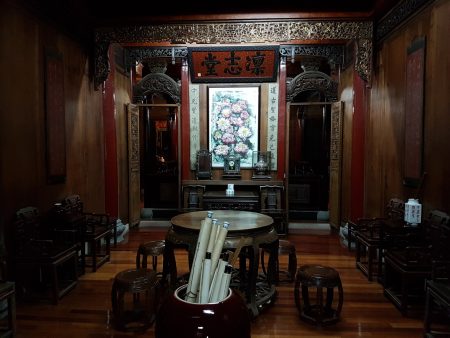
June 12th, 2016
Song dynasty poet Su Shi said “It is a lifelong pity if having visited Suzhou you did not visit Tiger Hill”. It’s perhaps surprising then that at the end of my third trip there I still hadn’t been. In my defence it’s actually a little way out of the city. I walked there from the hotel which took an hour or so.
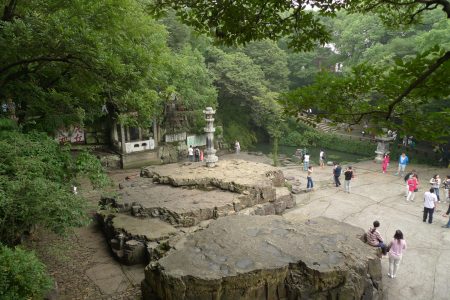
Most people who’ve heard of it but never visited, like myself, assume it’s all about the giant leaning pagoda featured on Suzhou’s city logo. But actually there’s a large landscaped scenic area with several famous attractions including this one called “Thousand People Rock”, and “Sword Testing Rock” which was cleaved in half by an ancient magical sword.
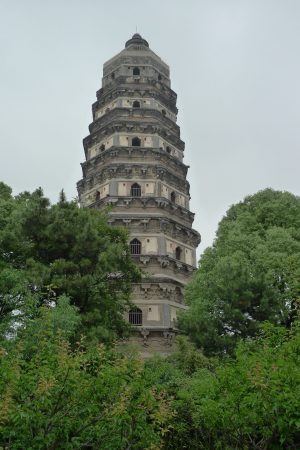
Anyway the main event is this pagoda. The Yunyan pagoda or “leaning tower of China”. It is over 1000 years old and has been slowly toppling over for the last 400 or so. Disappointingly they won’t let anyone climb up. It’s not like it’s going to finally fall over today is it?
June 1st, 2016
In what’s becoming an alarmingly regular occurrence, I’m back in China for work again. It seems to be the rainy season here, and the Saturday I arrived I experienced this torrential downpour as I wandered around the Jing-an temple in Shanghai.
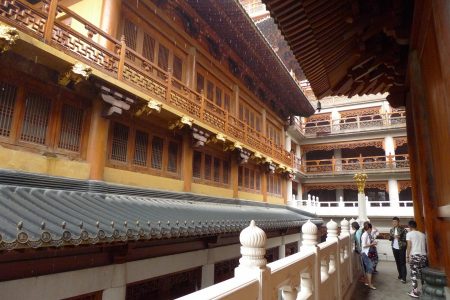
Sunday afternoon it cleared up a bit, and I went to see another temple, Jade Buddha temple. Walking back from there I found a bit of the city I actually quite liked, north of where I was staying in Zhongshan Park. There’s a river and a park and a university. It’s quite peaceful and not too crowded.
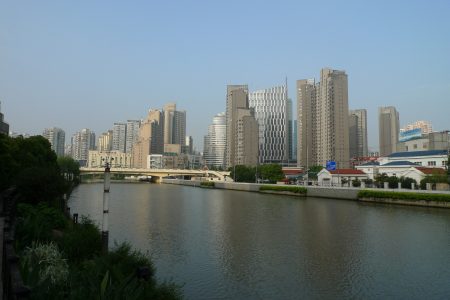
I was back in Suzhou as usual, for a rather stressful week of work. Friday afternoon the others left for the airport and I made an immediate start to my impromptu holiday by visiting the Hanshan temple. I’m definitely a sucker for the temple plus garden plus old building combo that the Chinese like to call a “scenic area”. This wasn’t the best I’ve been to, but it was a fun place to spend a few hours. Unfortunately I failed to make it to the top of the pagoda because on the second level the old guard shooed me out as it was closing time. :-(
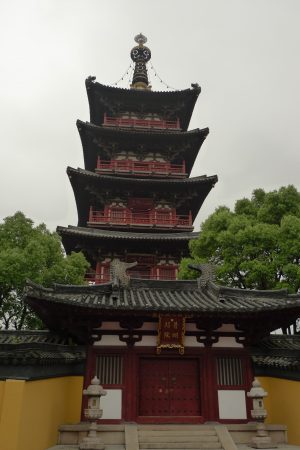























































































































































































































 Posts
Posts